2017 Wheat Disease Updates
Stripe Rust Update (4-25-17)
By: Jeanne Falk Jones, K-State Agronomist
At this time of the year, we listen intently to the south for reports on wheat stripe rust. Stripe rust is a fungal disease that moves into our area on southerly wind currents. And...it is fairly quiet about stripe rust straight to our south.
First and foremost, we are not yet finding stripe rust in northwest Kansas. I was out looking this last week and didn't come up with any! Lots of wheat streak mosaic virus, but no stripe rust.
For the state of Kansas, stripe rust is continuing to be found in southeast, south central and up through central Kansas. The counties closest to us include: Mitchell, Lincoln, Ellsworth, Rice, Reno, Pratt, Kiowa and Meade. Stripe rust is being found in those counties in the lower part of the canopy and has not moved to the flag leaf (even though the flag leaf is out in some of those counties).
The weather conditions in central Kansas just have not been very conducive to stripe rust development. That is why the stripe rust is being found, but seems to be staying in the lower canopy of the wheat. The conditions that are favorable to stripe rust development are frequent rainfall (or dew/fog) and temperatures in the 40-50F range at night. Temperatures over 75 degrees are not conducive to stripe rust development. And you must have a wheat variety that is susceptible to stripe rust.
So again this week in northwest Kansas, we are in the wait-and-see mode. Our wheat continues to grow and in some fields the flag leaf is just starting to peak out of the whorl of the wheat plant. We still have 7 days (or more with this cool weather) before a majority of the flag leaf is out. The general consensus is that our wheat is about a week to 10 days early this year.
Wheat disease update: Stripe rust, leaf rust, and powdery mildew (from eUpdate 4-21-17)
This week has brought more reports of stripe rust in Kansas. Stripe rust can be found in the lower and middle canopy of many fields in central Kansas, but the severity remains low (Figure 1). Stripe rust is more severe in the southeast region of the state and has moved to the upper leaves in some fields. The weather conditions the past 14 days have not favored the rapid spread of stripe rust. Stripe rust is favored by cool, wet weather and temperatures in recent weeks were too warm for the stripe rust fungus to function efficiently. For example, most areas of the state had more than 30 hours of temperatures above 75 F in the last two weeks (Figure 2). Some areas of southwest and south central Kansas had more than 50 hours of unfavorable temperatures. The threat of stripe rust has not passed, however. We know stripe rust is present at low levels in many fields in the state. The disease could increase rapidly if we get into another period of favorable weather with frequent rainfall and temperatures in the 40-50F range at night. I still think there is a moderate risk of Kansas having a serious problem with stripe rust this season.
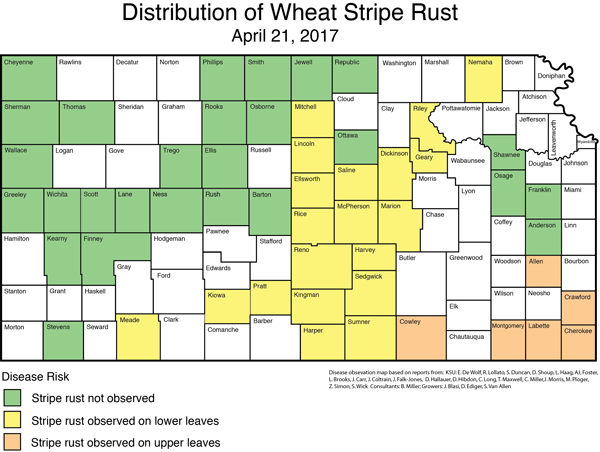
Figure 1. Distribution of wheat stripe rust in Kansas as of April 21, 2017.
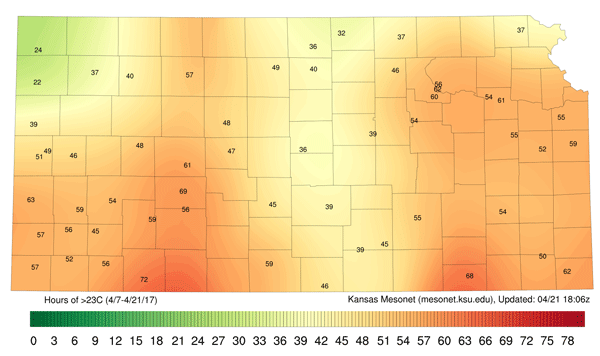
Figure 2. Duration of time that temperature was unfavorable for the development of stripe rust between April 7 and April 21, 2017.
Leaf rust was reported previously in south central and southeastern Kansas. This week brought a few new reports of leaf rust and indications that leaf rust has moved to the upper leaves in few areas (Figure 3). This movement of rust to the upper leaves is important because these leaves provide most of the resources the plants will use produce grain. Any damage done to the upper leaves increases the risk of yield loss.
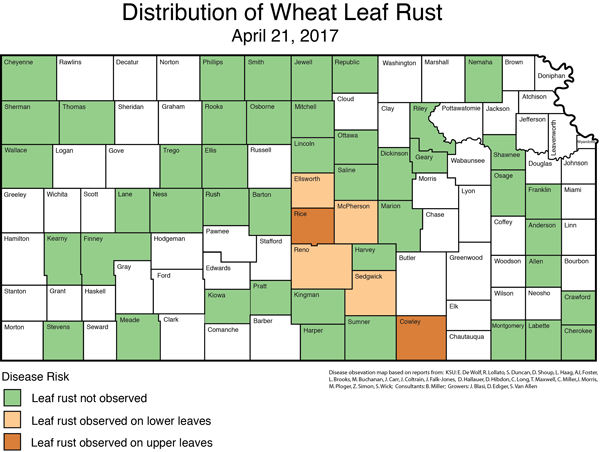
Figure 3. Distribution of wheat leaf rust in Kansas as of April 21, 2017.
Powdery mildew (Figure 4) is becoming severe in fields planted to moderately susceptible and susceptible varieties. 1863, Gallagher, KanMark, LCS Pistol, SY Flint, WB4458, WB-Grainfield, and WB-Redhawk are vulnerable to powdery mildew. In some fields, the powdery mildew has moved to the leaf just below the flag leaf prior to heading. This early establishment of the disease is cause for concern and growers should consider both rust and powdery mildew into their fungicide decisions. Fields with multiple diseases in the middle canopy and those where disease has moved to the upper leaves prior to heading have a more than 80% chance of experiencing a yield loss of >4.0 bu/a.
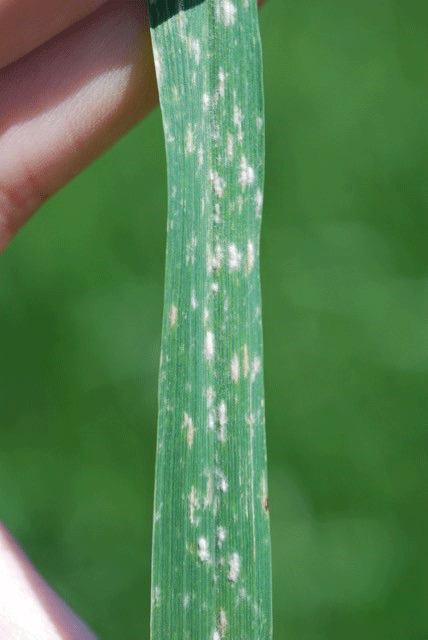
Figure 4. Wheat with symptoms of powdery mildew. Photo by Erick DeWolf, K-State Research and Extension.
Erick De Wolf, Extension Plant Pathology
dewolf1@ksu.edu
Romulo Lollato, Wheat and Forages Specialist
lollato@ksu.edu
Mary Knapp, Weather Data Library
mknapp@ksu.edu
Chip Redmond, Kansas Mesonet
christopherredmond@ksu.edu
Wheat Streak Mosaic Being Found
By: Jeanne Falk Jones, K-State Multi-County Agronomist
There continues to be wheat streak mosaic being found in wheat across northwest Kansas. Wheat streak mosaic is a virus that infects wheat by wheat curl mite feeding.
From a distance, the wheat likely has a yellow appearance. When you look closely at the wheat that is infected with wheat streak mosaic, it has a splotchy yellow and green appearance. We call that mottling on the wheat leaves.
Wheat curl mites are tiny insects that can't be easily seen with the naked eye. They move on the wind currents in search of green wheat to infect. In most cases, the yellow wheat seems to start on one side or one corner of the wheat field, progresses across the field and generally follows the wind direction. This is the case when there is a 'good' source of wheat curl mites – likely from volunteer wheat that is found in close proximity.
In other cases, there may be randomly scattered plants showing the mottling symptoms. Many times those plants are very noticeable because of their yellowing leaves. The appearance of scattered yellow plants can be from a 'decreasing' source of wheat curl mites. There may not be enough mites to move in-mass across a field, but there were a few mites being blown into the field by the wind. They landed on scattered plants and caused the mosaic symptoms.
Our weather conditions last fall were nearly perfect for wheat curl mite reproduction. Peak wheat curl mite reproduction is between 75 and 80 degrees and increased reproductive rates at temperatures over 70 degrees. We had several days after wheat drilling that met those conditions!
In addition, most of our wheat varieties have very little resistance to the wheat mosaic virus. Oakley CL is the most resistant variety planted in our area. However, its resistance is temperature sensitive. And with higher temperatures, the resistance breaks down.
With these conditions – prevalent volunteer wheat, warm conditions last fall and susceptible wheat varieties - coming together, we have the perfect storm for wheat streak mosaic to be a problem. And we are seeing that show up in wheat this spring.
If you have wheat that you are concerned about having wheat streak mosaic, let me know and I can take a look at it. Many times I can visually look at it and make an identification on the disease. To have a virus scan ran on your wheat, I can send in wheat samples to the K-State Plant Pathology Dignostic lab. The cost for this test is $15 and is usually needed for crop insurance claims.
To see pictures of wheat streak mosaic, check out the K-State Sunflower District website at www.sunflower.ksu.edu/agonomy. Pictures are also posted on my facebook page at K-State Sunflower District Agronomy and on twitter @CropsWithJeanne.
No Stripe Rust Found in Northwest Kansas (4-14-17)
By: Jeanne Falk Jones, K-State Multi-County Agronomist
I was out looking at wheat this week and have been finding one main disease – and it's not stripe rust! Unfortunately, it is wheat streak mosaic.
I checked the each of the wheat plots in Sunflower District closely for stripe rust and did not find any. The map of current infestation is showing counties stretching from south central to Riley County (Manhattan). In the areas that stripe rust is being found, it is showing up on varieties that are rated susceptible.
In northwest Kansas, we are still in the wait-and-see mode for stripe rust. Since stripe rust fungal spores move on the wind currents, we are listening to the south for stripe rust infestations. And it seems to still be quiet for stripe rust south of us (southwest Kansas, panhandles of Oklahoma and Texas). As you are looking at your wheat, if you see anything that might be stripe rust (or another disease), please let me know.
Wheat stripe rust on the move in Kansas (4-14-17)
From Extension Agronomy eUpdate
Stripe rust continues to be a top scouting priority for many wheat farmers in Kansas. The disease was reported for the first time this season about 7 to 10 days ago in parts of southeast and south central Kansas. Additional scouting efforts this week indicate that the disease is now established at low levels in many fields in the central region of the state (Figure 1). The disease was also reported on upper leaves of wheat in the southeast corner of the state. Currently, stripe rust is generally reported to be in the lower or middle canopy of wheat in central Kansas.
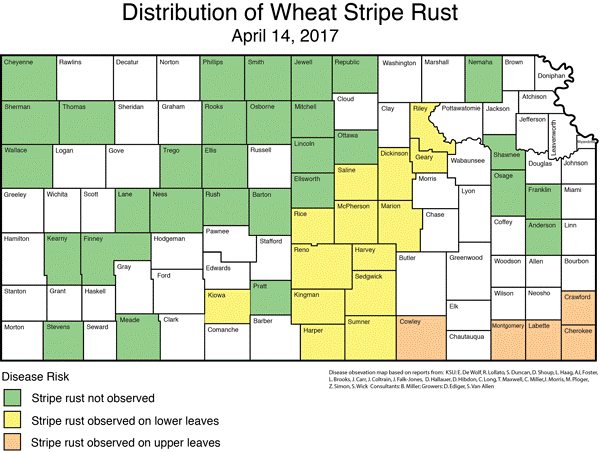
Figure 1. Current distribution of stripe rust in Kansas.
The stripe rust infections we are seeing now likely became established about two or three weeks ago, during a period of weather that was highly conducive to the disease. Stripe rust is favored by temperatures between 45-55 F and extended periods of high relative humidity. Many of the areas we are seeing stripe rust in now had more than 70 hours of favorable temperature and humidity between March 23 and April 6 (Figure 2). Some areas had more than 100 hours of favorable conditions.
Figure 2. Duration of time (hours) that weather conditions favored the development of stripe rust in Kansas between March 23 and April 6. This favorable period of weather likely helped the disease become established in many parts of central and eastern Kansas.
Interestingly, the weather in recent weeks was less conducive for the disease. The development of stripe rust can be suppressed by warm temperatures, and disease tends to slow when temperature is consistently above 75F. Night time temperatures are particularly important because this is when new stripe rust infections take place. We often see the development of stripe rust begin to slow when night time temperatures are above 60 F and temperatures during the day exceed 80 F for multiple days. Most areas of the state have reported more than 10 hours of temperature above 75F between March 31 and April 14 with parts for southeast and southwest Kansas reporting between 20-31 hours of suppressive temperature for the same time period. Unfortunately, this probably was not enough to suppress the development of stripe rust for long.
The 10-day weather forecast for many areas of the state indicates that temperature and moisture conditions are likely to favor continued development of stripe rust. There is a moderate to high risk of central and southeast Kansas having a severe problem with stripe rust this year. Growers in central Kansas should be actively scouting fields for stripe rust, and making plans to apply a fungicide if the disease is established in their fields.
Fields with good yield potential and seed production fields would be a top priority for a fungicide application because of the generally higher value of grain than general production fields. Varieties such as Armour, Everest, LCS Pistol, LCS Wizard, Garrison, Ruby Lee, and WB-Redhawk are known to be highly susceptible to stripe rust and should also be a top priority. Other highly susceptible varieties include Byrd, Denali, TAM 111, and TAM 112 -- each of which is grown primarily in western Kansas.
-Erick De Wolf, Extension Plant Pathology
-Romulo Lolatto, Wheat and Forages Specialist
-Mary Knapp, Weather Data Library
-Chip Redmond, Kansas Mesonet
Early reports of stripe rust and leaf rust in wheat
From Erick DeWolf, K-State Wheat Pathologist
Stripe rust: There have been some early reports of stripe rust in Kansas this week. The K-State Extension Team has been out scouting to help document its distribution in the state. To date, most of the reports of stripe rust have come from southeast Kansas where the crop is at boot and heading stages of growth (Figure 1). There have been a few reports of stripe rust in the south central region of the state. Wheat in this part of the state is at flag leaf emergence and approaching boot stages of growth. The disease is mostly in the lower or middle canopy at the moment but there are few reports of stripe rust in the upper canopy in the southeast.
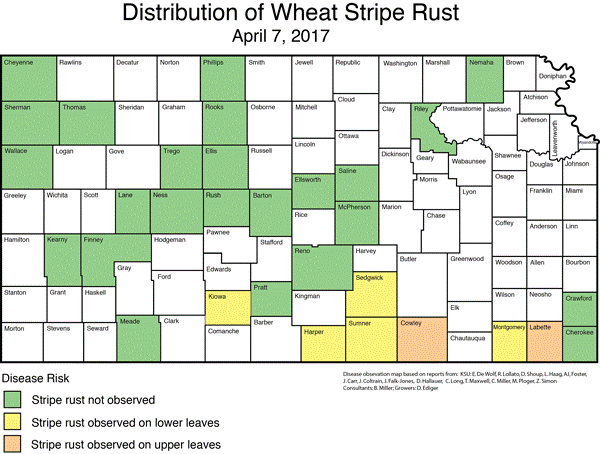
Outlook for severe stripe rust: The recent period of cool temperatures and frequent rainfall has been highly conducive for the continued spread of the disease. We will likely see more signs of disease continuing to show up over the next 14 days. What happens after this first wave of infections is critical to the development of an epidemic. The risk of severe disease and yield loss will increase if we get into another period of cool temperatures (44-55 degrees F) and frequent rains. Temperatures above 60 F at night often slow the development of stripe rust.
From Jeanne Falk Jones, K-State Multi-County Agronomist
With the stripe rust being found in south central Kansas, stripe rust has been found a little closer to us. For right now, we are listening to the south for reports of stripe rust being found. Since we are still a little ways off from thinking about fungicide applications, we should talk about everything that needs to come together to get a stripe rust infection.
There really has to be three things come together to get a stripe rust infection. First, you must have a susceptible wheat variety. In southeast and south central Kansas, the stripe rust has been found in the Everest variety. Everest is susceptible. Second, you must have the presence of the disease. In this case, you need stripe rust fungal spores moving in on the wind currents. Finally, you must have the right environmental conditions for the disease to infect the leaf. The leaf of the wheat plant must have a layer of moisture on the leaf for the rust spore to infect. This can be from dew on the leaves. In addition, the infection period for the fungal spore to develop into an orange stripe rust pustule is generally about 14 days.
So, for now, keep your ear tuned to the areas south of us and listen for stripe rust reports. I will keep in the loop on what is being found to the south of us.
From Erick DeWolf, K-State Wheat Pathologist
Stripe rust was reported in Southeast Kansas today (April 4th). This is the first report of stripe rust in Kansas for the 2017 growing season.
The find was made by the KSU Agronomy Agent in the Wildcat Extension District. The stripe rust was found in Montgomery County that borders OK in the Southeast corner of the state.
The wheat variety was "Everest" which is known to be susceptible to stripe rust. The crop was planted in September (early for this part of the state) and is now at the heading stages for growth. The weather conditions have been highly conducive for the disease in recent weeks and wheat growers in the state should intensify their scouting efforts.
From Jeanne Falk Jones, K-State Multi-County Agronomist
You might have heard – stripe rust was found in Kansas on Monday. It was found in very southeast Kansas – just about as far as you can get away from us in the state. It was found in the lower canopy in a field of an early planted field of Everest (susceptible variety).
What does that mean for us in northwest Kansas? Really it doesn't mean too much for our immediate future. The fungal stripe rust spores are moved by wind currents. Since the predominant wind direction in the spring is southern/southwestern, we listen to reports from the south to help predict stripe rust infestations in our wheat.
Listening to the south, it has been very quiet for discussion of stripe rust. Reports from Oklahoma have generally been very few. There are reports of stripe rust found on the Oklahoma/Texas border south of Oklahoma City and another east of Stillwater. The wheat pathologists in Oklahoma are out and about scouting fields. They are reports a few viral diseases and some other early season fungal diseases (powdery mildew and tan spot), but not much stripe rust at all. They are sending out reports as they are finding diseases, so we are listening intently to what they are finding.
The Colorado State folks have also been out looking at wheat in southern Colorado and are also not finding any stripe rust yet this spring. They are also reporting that wheat streak mosaic is being found.
And straight south of us in Kansas, stripe rust has not been found. We are out looking across the state and reporting back to Erick DeWolf (K-State wheat pathologist).
So, I will keep you up to date on what is being found in the field. At this point no news of stripe rust south of us is good news for our wheat!
Greenbugs: pale green with dark green stripe down back
Seedlings - 50 greenbugs/linear ft of row
3 to 6" wheat - 100 to 300 greenbugs/linear ft of row
6 to 10" wheat - 300 to 500 greenbugs/linear ft of row
Bird Cherry Oat Aphid: olive green colored
At boot to heading stage - 50+ per tiller
Russian Wheat Aphid: light green body
Around 20 bu/ac yield potential - 20% of tillers show symptoms and have live aphids
40 bu/ac + - 10% of tillers show symptoms and have live aphids
Are Viruses Always Found in Volunteer Wheat?
Last fall, volunteer wheat fields were sampled in Sherman and Cheyenne Counties to determine the level of wheat virus infections. The wheat was tested for Wheat Streak Mosaic, High Plains Mosaic and Triticum Mosaic and a combination of these. Erick DeWolf, K-State Wheat Pathologist and I randomly selected these volunteer wheat fields.
Each of these viruses are vectored by the wheat curl mite and can be moved from volunteer wheat into planted wheat fields. Spring infections of these viruses tend to have less impact on yield when compared to fall infections.
Cheyenne County
Triticum Mosaic 3.1%
Wheat Streak Mosaic 28.1%
High Plains Mosaic 31.2%
Triticum + Wheat Streak 6.3%
Wheat Streak + High Plains 3.1%
66% of plants were infected with a wheat virus. 32 plants were sampled.
Sherman County
Triticum Mosaic 0%
Wheat Streak Mosaic 9.8%
High Plains Mosaic 9.8%
Triticum + Wheat Streak 2.7%
Wheat Streak + High Plains 17.1%
39% of plants were infected with a wheat virus. 41 plants were sampled.
The combination was tested for because individually, these viruses can have impacts on yield. However, when these are put in combination the yield effects can be catastrophic.
When identifying these viruses, they all look very similar. They all have the mottled yellow streaks that are concentrated on the leaf tips. As the leaves become progressively more yellow with time, the leaf veins will often retain a greener color. Therefore, the determine the virus that is causing the symptoms, a plant sample should be sent into the plant pathology lab at K-State.
There is no cure for viruses in wheat. These are likened to the flu in humans. Healthy wheat (not lacking on fertilizer, drought stressed, etc) will generally fight the virus longer without seeing symptoms and will have less yield loss than wheat that has poorer health. The best cure for wheat viruses is prevention. Controlling volunteer wheat is a great prevention option.